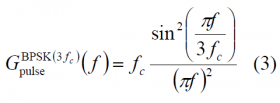If you wish to contribute or participate in the discussions about articles you are invited to contact the Editor
Generic BCS Signals: Difference between revisions
Carlos.Lopez (talk | contribs) (Created page with "{{Article Infobox2 |Category=Fundamentals |Title={{PAGENAME}} |Authors= J.A Ávila Rodríguez, University FAF Munich, Germany. |Level=Advanced |YearOfPublication=2011 }} In the p...") |
Carlos.Lopez (talk | contribs) No edit summary |
||
| (One intermediate revision by the same user not shown) | |||
| Line 1: | Line 1: | ||
{{Article Infobox2 | {{Article Infobox2 | ||
|Category=Fundamentals | |Category=Fundamentals | ||
|Authors=J.A Ávila Rodríguez, University FAF Munich, Germany. | |||
|Authors= J.A Ávila Rodríguez, University FAF Munich, Germany. | |||
|Level=Advanced | |Level=Advanced | ||
|YearOfPublication=2011 | |YearOfPublication=2011 | ||
|Title={{PAGENAME}} | |||
}} | }} | ||
Two particular cases of the [[Binary Coded Symbols (BCS)|BCS modulation]] are the [[Binary Phase Shift Keying Modulation (BPSK) |BPSK]] and [[Binary Offset Carrier (BOC)|BOC]] modulations. Nonetheless, we show in the next lines how the [[Autocorrelation & Power Spectral Density|Power Spectral Density (PSD)]] of a generic BCS could be derived. | |||
Let us assume a BCS signal with vector s = [+1, +1, -1]. We have thus <math>s_1 = +1 , s_2 = +1 , s_3 = -1</math>. The modulating term of the PSD can be easily calculated as: | Let us assume a BCS signal with vector s = [+1, +1, -1]. We have thus <math>s_1 = +1 , s_2 = +1 , s_3 = -1</math>. The modulating term of the PSD can be easily calculated as: | ||
| Line 31: | Line 31: | ||
== | == Credits == | ||
The information presented in this NAVIPEDIA’s article is an extract of the PhD work performed by Dr. Jose Ángel Ávila Rodríguez in the FAF University of Munich as part of his Doctoral Thesis “On Generalized Signal Waveforms for Satellite Navigation” presented in June 2008, Munich (Germany) | |||
[[Category:Fundamentals]] | [[Category:Fundamentals]] | ||
[[Category:GNSS Signals]] | [[Category:GNSS Signals]] | ||
Latest revision as of 09:11, 25 November 2011
| Fundamentals | |
|---|---|
| Title | Generic BCS Signals |
| Author(s) | J.A Ávila Rodríguez, University FAF Munich, Germany. |
| Level | Advanced |
| Year of Publication | 2011 |
Two particular cases of the BCS modulation are the BPSK and BOC modulations. Nonetheless, we show in the next lines how the Power Spectral Density (PSD) of a generic BCS could be derived.
Let us assume a BCS signal with vector s = [+1, +1, -1]. We have thus [math]\displaystyle{ s_1 = +1 , s_2 = +1 , s_3 = -1 }[/math]. The modulating term of the PSD can be easily calculated as:
which can be further simplified to:
while
Thus the spectrum of this BCS sequence would adopt the following form:
In general, in order to understand how the spectrum will look like for a given sequence, we have to be able to understand how every term of the sum above contributes to the total PSD.
Credits
The information presented in this NAVIPEDIA’s article is an extract of the PhD work performed by Dr. Jose Ángel Ávila Rodríguez in the FAF University of Munich as part of his Doctoral Thesis “On Generalized Signal Waveforms for Satellite Navigation” presented in June 2008, Munich (Germany)




